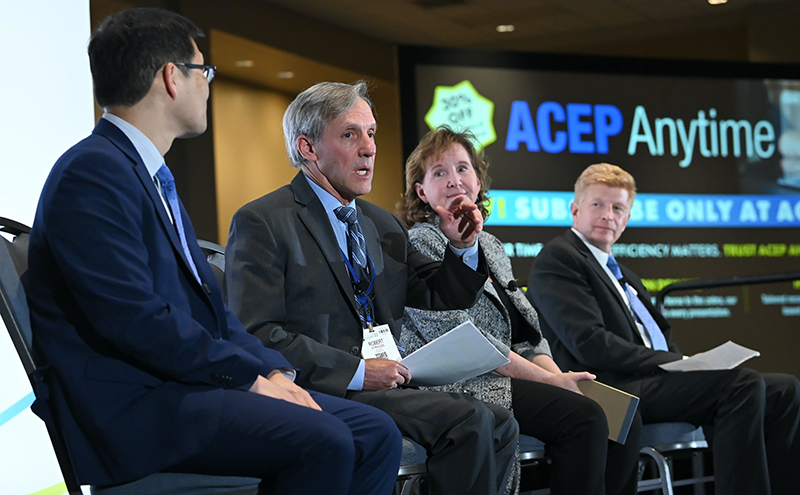Before heading into Tuesday’s James D. Mills, Jr., Lecture at ACEP23, panelist Robert W. Strauss, MD, FACEP, said he was chatting with somebody in the back of the room and mentioned that serving in professional development as Chief Medical Training Officer at TeamHealth is his favorite part of the job.
Dr. Strauss said his goodbye started toward the stage. “And as I’m walking away, he said, ‘Good luck making it out alive.’”
The ice breaker generated a laugh from attendees. It also served as a segue to “A Primer and Discussion of EM Employment Models.” Candid discussion from experts looked at the pros and cons of different employment models, but a focus for moderator ACEP Immediate Past President Chris Kang, MD, FACEP; and panelists James G. Adams, MD, FACEP and Tracy G. Sanson, MD, FACEP, was the future of emergency medicine.
Panelists discussed the impact of private equity, the challenges of insurers and payment, and they agreed emergency medicine is facing enormous challenges and working out of the current crisis will take a unified voice.
“The crisis is raining down on emergency medicine,” said Dr. Adams, Senior Vice President and Chief Medical Officer of Northwestern Medicine, an 11-hospital health system. “What has been emergency medicine’s response? Adapt as we always do. That’s to your credit. I admire you for it, and now it’s time to stop.”
He said for some, there has been debate “whether United States emergency departments actually needed an emergency physician. How dare we have that debate.”
Dr. Sanson, who practices clinically as an independent contractor, began the discussion by looking back at how emergency medicine got here. She pointed out that a similar session she helped deliver in 2022 discussed that health care is sick, individuals are not OK, systems are not OK and generally, the United States is not OK.
Then, 2023 came, and it wasn’t any better.
Bankruptcy filings from OPXS (Optex Systems Holdings, Inc) and Envision, followed by the American Physician Partners “closing up shop, sending out an email on the 17th of July saying, by the way, after the 31st, we won’t be here anymore and had a total of 18 states, 155 EDs and 2,500 emergency physicians and other clinicians who were suddenly left standing bewildered and feeling rejected and quite abandoned.”
With other recent changes, such as Optum laying off nurses, Dr. Sanson said the panelists changed the session’s focus to how emergency medicine moves into its next phase.
“For the individual sitting here, I’ll tell you what made me say yes to doing this lecture,” Sanson said. “About a year ago, I felt an anger welling about where emergency medicine was. What happened to the emergency medicine that I trained in, that I grew up in, that we worked so hard to say we were emergency physicians? I saw it dissolving in front of us. One of the bright spots is that the FTC has (sued) the U.S. Anesthesia Partners, saying they were monopolizing and consolidating and re-setting some prices. I’m hoping there will be some checks and balances that continue to work in our favor.”
One of the challenges emergency medicine faces, Dr. Kang said, is consolidation. Dr. Kang, who is an attending physician at Madigan Army Medical Center in Washington state, addressed the ACEP Council on Saturday and encouraged ACEP Councillors to have the right discussion because it’s easy to oversimplify issues.
“Consolidation, corporatization, private equity, etc., they all may overlap, but they’re distinct,” he said. “If we’re going to have the right discussion, let’s have the right understanding. So let’s talk about consolidation.”
Dr. Kang turned to Dr. Strauss, who pointed out that in 2019, 62 percent of clinicians across medicine worked in hospitals, hospital systems and large groups. In 2022, that number grew to 74 percent. Of that group, 70 percent work in hospitals and hospital systems.
He said further consolidation could be inevitable when you look at recent trends, mostly because the pandemic created a lot of uncertainty, frustration, and financial frustration.
“Physicians want financial certainty, particularly in a decreasing reimbursement environment,” he said. “They want decreased complexity and the potential – we all do – to have more balance. EM is at high risk for consolidation.”
Dr. Strauss said there might be benefits to consolidation because size matters. A focused support staff working on programs to make emergency physicians’ practices more efficient could help in the time of greatest need. Success depends on how the emergency physician is treated.
“Physicians are valued, have access to optimal resources and are paid well at the highest percentages of net revenue. Done right also means the team and organization fights for your rights,” Dr. Strauss said.
When searching for a place of employment, Dr. Adams encourages emergency physicians to follow the money.
“The people who allocate the money are the only ones that have power,” he said. “It needs to flow through somebody who shares your values.”
Dr. Sanson said transparency is crucial and told attendees about an ACEP resource that was just released. ACEP Open Book, powered by Ivy Clinicians, uses data from emergency physician employers and allows potential job seekers to learn about employers. It includes data about compensation, number of patients, numbers of staff members, group or hospital size, and employer leadership.
“A presentation like this isn’t to give you absolutely all the information you need,” Dr. Sanson said. “It’s to pique your interest to go get more on your own. I did ask the question. How many emergency departments do we have in the United States? How many are military, VA? How many are health systems? How many are individual? I didn’t get good answers. I think one of the ways we’re going to progress and get to a better side of where are right now is if we have transparency and education for the individual physicians.”
Visit ACEP Open Book at openbook.acep.org.





